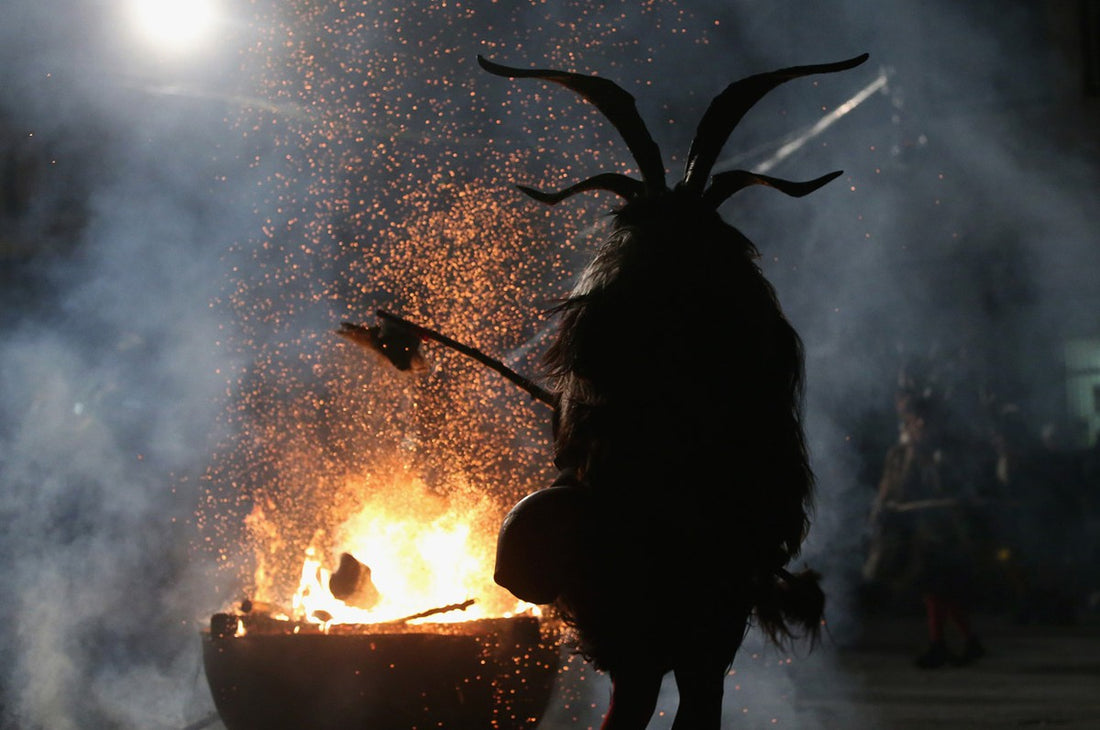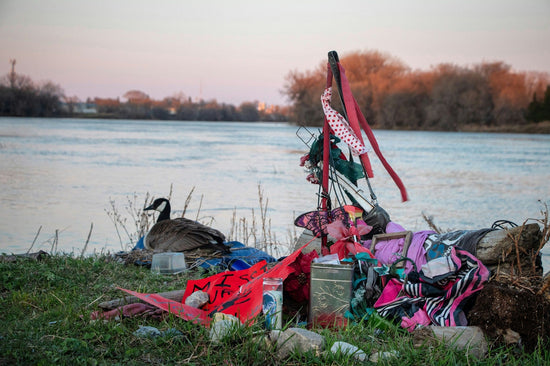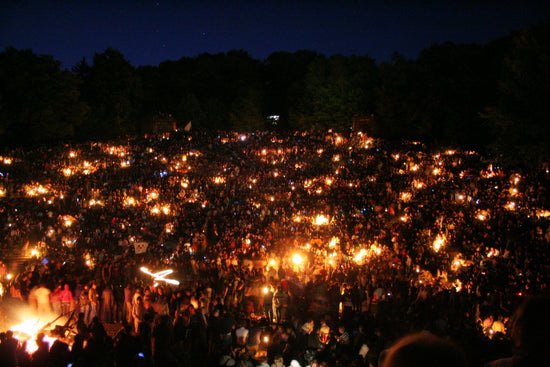If you think Christmastime is all about sleigh bells ringing and fighting crowds at the mall, you’re in for a surprise. The cheery, consumer-focused holiday we know today here in the States looks very different from its origins.
In the beginning, pagan traditions of winter consisted of rambunctious merrymaking. People celebrated with significant amounts of alcohol, and the poor would flock to the homes of the well-to-do, demanding food and drink. Failure to acquiesce would likely lead to mischief.
Along with these raucous festivities came a dark figure. He’s half-demon, half-goat, with shaggy black fur, long snake-like tongue, and flamboyant horns. He spreads terror throughout the town, chasing children on his cloven feet. You’ll find him sporting bells, with thundering chains swinging about his grizzly torso. His name is Krampus.
Who, or what, is Krampus anyway?

Source: Throne & Vine
Krampus was born out of Alpine folklore. He’s the badass counterpart of St. Nicholas, sent to punish the naughty children of the world. While Old Saint Nick goes around rewarding the well-behaved kids, Krampus comes in to punish those who’ve been acting up. And he ain’t messin’ around, either. He’s doing a lot worse than handing out coal.
Our loathsome hero is known to carry around a bundle of birch sticks, ready to whip deviant children into submission. A basket is strapped to his back to transport the most ill-behaved kids back to his lair, doomed for an unknown fate.
Krampus has more than one tactic to punish those he gets his claws on. He’s been said to use both his birch sticks as well as his chains for lashings. Worse yet, his rap sheet also includes kidnapping, drowning, and eating children.
A brief history of Krampus
Although there’s some debate over the exact origin of Krampus, he seems to have risen out of the ashes of old pagan celebrations of winter solstice, the longest night of the year. He dates back in Germanic folklore as early as the 1600’s. Some speculate that he’s the son of Hel, the Norse goddess of death and the underworld.
Others believe he originated from the Horned God of Witches, a deity found in Wicca and some forms of neopaganism. The Horned God is associated with wilderness, sexuality, nature, and hunting. He is depicted with a beast’s head and horns, symbolizing the union of the divine and the animal.
With the spread of Christianity, our terrifying friend became associated with Christmas, much to the chagrin of the Catholic church, who attempted to ban him due to his strong resemblance to the devil. It wasn’t the only time there was an attempt to thwart the Christmas devil, but Krampus always prevailed.
For people in the alpine regions, celebrating Krampus is as much a part of winter customs as taking photos with Santa Claus is to us Americans. The Yuletide traditions begin in early December and continue throughout the month. Although some of these celebrations may seem ghoulish to those that think of Christmas as “the most wonderful time of the year”, they’re a way of celebrating the dark and light parts of the season.
The Festival of Krampusnacht

Source: festivalsherpa.com
Krampusnacht (Krampus night) starts things off on December 5th, the eve of St. Nicholas day. Traditionally, on this suspenseful evening, children would leave a shoe outside their door. The next morning, they would get their first warning - if they’d behaved, their shoe would be full of presents left by the Saint. If they’d been naughty, Krampus would leave a birch stick as a warning that he was onto them.
These days, Krampusnacht is more of a wild, boisterous celebration of terror and fun. There’s feasting, parades, a lot of people dressed as Krampus, and no shortage of imbibing (with the beverage of choice being schnapps).
For even more fun, celebrators participate in Krampuslauf, or the annual Krampus run. Originally, the idea was to ward off evil spirits. Although that sentiment might still remain intact somewhere, it appears that now it’s mostly about getting sloshed and wearing amazingly horrific costumes while running the streets harassing festival-goers.
Regional celebrations
Krampus has been celebrated throughout the alpine regions for decades, but as his popularity has grown, festivals are continuing to pop up around the world. You’ll find some of the oldest and most traditional events in areas like South Tyrol and Salzburg, Austria.
One of the largest Krampuslauf events takes place annually in Schladming, Austria. This grand party boasts around 800 Krampus-claden folk, nearly 8,000 spectators, and one giant afterparty.
When the popular Christmas horror movie came out in 2015, events started spreading in the United States. Now cities like Los Angeles, San Francisco, Portland, Oregon, New Orleans, and even our own Bellingham, Washington hold their own festivities each year.
Traditional Krampus costumes
While The U.S. has caught Krampus fever and enjoys a night of lavish jubilation, people in Austria and Germany take the traditions more seriously. They spend months preparing for these events, handcrafting costumes, and carving masks.
The most authentic of costumes are even considered folk art. There’s entire museums devoted to this goaty demon, filled with ghastly masks and sheep skins.
Traditional masks are made with hand-carved wood and feature intricate details. In one town in Austria, renowned artist Ludwig “Luggi” Schnegg has been proudly hand-carving masks for all 80 members of the Haiming Krampus group since 1981. And yes, Krampus groups are a thing.
How Krampus became cool

Between 1890 and WWI, manufacturers in the alpine regions started sending out Krampus Christmas cards. It was the boom in the postcard industry in Austria and Germany during this time that began the commercialization of our demon friend.
The sweet face of Krampus won over the public in these postcards, spreading cheery messages like “Gruss Vom Krampus” (Greetings from Krampus) and “Brav Sein” (Be Good).
Over a century later, he finally made his way across the ocean and into the hearts of Americans. Monte Beauchamp, an art director and graphic designer, believes he’s largely responsible for the demon’s popularity here. After Beauchamp published a book of Krampus cards and put together an art show featuring the Christmas devil in 2004, the legend became more mainstream.
Now, Krampus is popping up in pop culture references all over the place.
So, will the demon goat be coming to a neighborhood near you this winter? If so, you better start actin’ right (and it wouldn’t hurt to keep a bottle of schnapps on hand).
Want to celebrate Krampus in your own home? We created a series of products that we feel embodies the spirit of Krampus. The inviting, wintery scent of these products is inspired by the yuletide season, of cozying up to the fire, and long dark nights.
Check out our Krampus incense and other beastly, festive delights.
Feature image sourced from The Atlantic.






2 comments
I am fascinated by this company, and I am trying to understand it better. Why is Krampus celebrated if he did bad things to punish children? I’m not judging. I truly want to understand. I am so glad I found this company. The products are of the highest quality I’ve ever found. And, I feel connected when I use them.
I liked it when you said that if you think Christmastime is all about sleigh bells ringing and fighting crowds at the mall, you’re in for a surprise. My kid is fond of arts and crafts. I think a Wiccan art would be a great gift on his birthday. I will be looking for wiccan supplies in town. https://artesandcraft.com/wiccan-shop